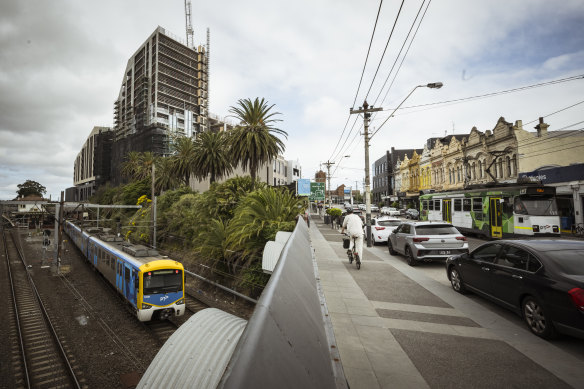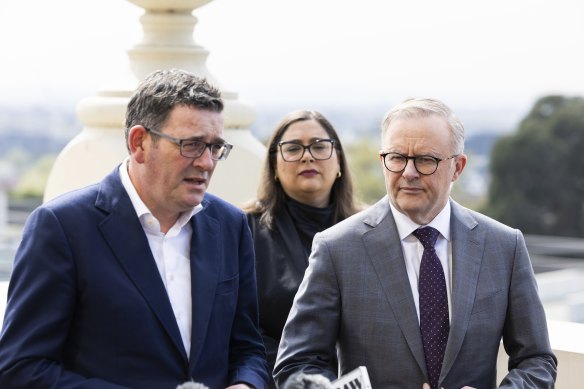Fifty new areas getting fast-tracked high-rise apartments. Here’s where
Melbourne’s suburbs will be transformed in a city-shaping plan to fast-track hundreds of thousands of new homes across 50 neighbourhoods.
The bold plan will reshape the skyline, with high-rise buildings to pop up across the suburbs – particularly in some of the leafiest and most expensive areas in the city’s east and south-east.

The area surrounding Malvern station has older low-rise buildings on one side, and a new tower under construction opposite.Credit: Photograph by Chris Hopkins
Premier Jacinta Allan will today reveal that Toorak, Armadale, Brighton and Sandringham are among the suburbs where 50 new activity centres – transport hubs zoned for higher-density living – will be designated to help ease the housing crisis.
Taller apartment buildings will be fast-tracked across the 50 sites in a shift that will transform the skyline of the city’s south-east.
But the plan, Labor’s most daring city-building vision since it announced the Suburban Rail Loop, is expected to face a fierce backlash from the Coalition and residents, who were also highly critical of the state government’s first 10 activity centres, revealed by The Age in August.
Housing in the first 10 zones will vary between three and 20 storeys, but it is not yet known what the height limits will be in the 50 new activity centres.
Councils are now in caretaker mode due to local government elections, hampering their ability to object to the government’s plan to seize planning controls.
The 50 new “train and tram zone” activity centres, which will fast-track multi-storey developments by 2026, are located along train lines. The first 25 new sites to be named today are concentrated within Melbourne’s eastern and south-eastern middle ring, areas with some of the highest property prices in the city.
Four activity centres will be added to the Frankston line at Toorak, Hawksburn, Armadale and Malvern stations. The south-eastern suburbs will also host additional activity centres at Carnegie, Murrumbeena, Hughesdale, Oakleigh, Tooronga, Gardiner and Darling stations.
Another four activity centres are slated for the Sandringham line at North Brighton, Middle Brighton, Hampton and Sandringham stations.
Six activity centres will be established – at Hawthorn, Glenferrie, Auburn, Blackburn, Nunawading and Mitcham stations – along the Belgrave and Lilydale lines.
In the west, new activity centres are also planned for Middle Footscray, West Footscray and Tottenham stations.
The Allan government says the zones are ripe for development because they are serviced by busy train lines that have benefited from level-crossing removals and will be even more freed up when the Metro Tunnel opens in 2025.
Under the government’s existing activity centre proposal, the planning process for multi-storey residential dwellings will be fast-tracked from up to five years to as little as 12 months. Residential construction would also be streamlined for developments that meet their new height limits.
The 10 existing centres – at Broadmeadows, Camberwell, Chadstone, Epping, Frankston, Moorabbin, Niddrie, North Essendon, Preston and Ringwood – mostly have height limits of up to 12 storeys, dropping to six storeys further away from transport.
However, the government has promised to consult councils and residents on the height limits for its 50 new centres as well as areas up to 800 metres from local transport hubs.
Of the 25 new zones with a known location, all but one is attached to a train station. The government says this is a result of feedback from the first 10 activity centre plans. The one exception so far, at Toorak Village, is directly serviced only by the route 58 tram.
The locations for the remaining 25 activity centres will be announced later this year.
The 10 existing zones are expected to squeeze an extra 60,000 homes into Melbourne’s suburbs. Sunday’s announcement, the first in a string of housing policies to be unveiled a year after last year’s housing statement, could fast-track many more.
Before he left office, former premier Daniel Andrews set a target of delivering 80,000 homes a year, or 800,000 over a decade. Allan, his successor, has for months said more needs to be done after last year’s suite of housing reforms.
But the push to squeeze more homes into Melbourne’s suburbs is not without its critics. More than 400 people gathered at Camberwell Primary School on October 6 to voice their concerns about heritage and councils being locked out of the objection process.
In a sign the government anticipates community angst about it plans, Toorak Village and Middle Footscray will be classified as smaller “neighbourhood activity centres”, with more modest growth compared to other zones.
Taller buildings at Toorak Village are typically only two or three storeys tall. This is also the case for Buckley and Errol streets in Footscray, the roads that flank Middle Footscray station.
However, similar building heights are also typical for streets adjacent to Armadale, Middle Brighton and North Brighton stations, but these areas have not been given the same treatment.
KPMG Australia planning and infrastructure expert Terry Rawnsley said the push for greater density in Toorak and Brighton might come as a “bit of a shock” to those residents.
However, he stressed that well-serviced suburbs had been earmarked for greater development since the early 2000s in planning documents that had otherwise just sat on a shelf gathering dust.
“The problem we’ve had is that housing supply has come out of places like Docklands, the CBD, South Yarra,” Rawnsley said. “We have to start looking further afield for the next apartment growth fronts to get more housing in.”
The economist said he suspected a lot of “hard work” would occur in the next two years to figure out what is feasible for suburbs previously sheltered from developments of six storeys or more.

Melbourne’s house builds over the next 10 years will be informed by the plans of former premier Dan Andrews. Credit: Paul Jeffers
“If you think of the Kensingtons and the Brunswicks, they were pretty much the same – lots of single, two or three storeys.
“Now, those communities don’t bat an eyelid when these apartment buildings go up. There’s more workers to serve the community, and people realise it’s not the end of the world when an apartment building is being built in your suburb.”
KPMG analysis published last month found Melbourne’s eastern suburbs have experienced a 2.5 per cent drop in residents of prime working age (20 to 64) in recent years. Perth and Brisbane have experienced the opposite.
Another KPMG study, from last year, found NSW was better than Victoria at building homes close to train stations. Half of the homes built in Greater Sydney between 2006 and 2021 were located within one kilometre of a train station, compared to just 35 per cent in Greater Melbourne.
Swinburne University’s Dr Stephen Glackin, an expert on urban planning, said he was initially taken aback by the scope of the overhauled activity centre plan.
“I’m quite surprised they’re rolling it out so boldly,” he said.
However, Glackin said increased housing density across Melbourne was ultimately the right thing to do.
“We have to have a citywide think about this. Not a local council think. The state has to take control.”
Allan said in a statement that the 50 new activity centres would provide more homes for young people to rent or buy close to public transport.
“I know it won’t fix everything, but it will deliver more homes and new life to inner suburbs that are full of jobs, transport and services – where young buyers and renters are currently locked out.”
The government’s year-long plan to supercharge housing approvals remains a major challenge.
In the 12 months to the end of June, Victorian councils approved 51,656 houses, flats and townhouses for construction. This represents the lowest result since the 2012-13 financial year.
Groups such as the Housing Industry Association predict only a slight increase in dwellings for 2025.
Opposition planning spokesman James Newbury, the MP for Brighton, yesterday slammed the Allan government’s housing record.
“Don’t be conned by Labor’s spin. They will never fix the housing crisis, they will only ever make it worse.”
The Morning Edition newsletter is our guide to the day’s most important and interesting stories, analysis and insights. Sign up here.